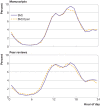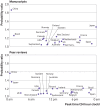Working 9 to 5, not the way to make an academic living: observational analysis of manuscript and peer review submissions over time
- PMID: 31857333
- PMCID: PMC7222960
- DOI: 10.1136/bmj.l6460
Working 9 to 5, not the way to make an academic living: observational analysis of manuscript and peer review submissions over time
Abstract
Objective: To determine whether researchers are submitting manuscripts and peer reviews to BMJ journals out of hours and whether this has changed over time.
Design: Observational study of research manuscripts and peer reviews submitted between 2012 and 2019 for which an author's address could be geocoded.
Setting: Online BMJ submission systems for two large general medical journals.
Main outcome measures: Manuscript and peer review submissions on weekends, on national holidays, and by hour of day (to determine early mornings and late nights). Logistic regression was used to estimate the probability of manuscript and peer review submissions on weekends or holidays.
Results: The analyses included more than 49 000 manuscript submissions and 76 000 peer reviews. Little change over time was seen in the average probability of manuscript or peer review submissions occurring on weekends or holidays. The levels of out of hours work were high, with average probabilities of 0.14 to 0.18 for work on the weekends and 0.08 to 0.13 for work on holidays compared with days in the same week. Clear and consistent differences were seen between countries. Chinese researchers most often worked at weekends and at midnight, whereas researchers in Scandinavian countries were among the most likely to submit during the week and the middle of the day.
Conclusion: The differences between countries that are persistent over time show that a "culture of overwork" is a literal thing, not just a figure of speech.
Published by the BMJ Publishing Group Limited. For permission to use (where not already granted under a licence) please go to http://group.bmj.com/group/rights-licensing/permissions.
Conflict of interest statement
Competing interests: All authors have completed the ICMJE uniform disclosure form at www.icmje.org/coi_disclosure.pdf (available on request from the corresponding author) and declare: no support from any organisation for the submitted work; AGB has received research grants from the Australian National Health and Medical Research Council; SS works for The BMJ; the authors have reviewed for and submitted articles to The BMJ and BMJ Open, often out of hours; no other relationships or activities that could appear to have influenced the submitted work..
Figures




References
-
- Burrows R. Living with the H-Index? Metric Assemblages in the Contemporary Academy. Sociol Rev 2012;60:355-72 10.1111/j.1467-954X.2012.02077.x. - DOI
-
- Altbach PG, Reisberg L, Rumbley LE. Trends in Global Higher Education: Tracking an Academic Revolution. United Nations Educational, Scientific and Cultural Organization, 2019.
Publication types
MeSH terms
LinkOut - more resources
Full Text Sources
